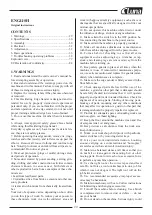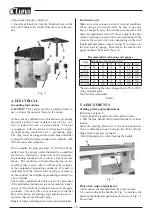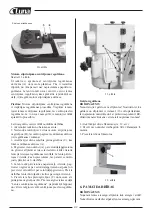
29
ENGLISH
Original instructions
CONTENTS
1. Warnings ...............................................................29
2. Specifications ........................................................30
3. Assembly ...............................................................30
4. Electrical ...............................................................32
5. Adjustments...........................................................32
6. Basic operations ....................................................36
7. Troubleshooting operating problems ....................38
Exploded view ..........................................................79
EC Declaration of conformity ...................................84
1. WARNINGS
1. Read and understand the entire owner’s manual be-
fore attempting assembly or operation.
2. Read and understand the warnings posted on the
machine and in this manual. Failure to comply with all
of these warnings may cause serious injury.
3. Replace the warning labels if they become obscured
or removed.
4. This Oscillating Edge Sander is designed and in
-
tended for use by properly trained and experienced
personnel only. If you are not familiar with the proper
and safe operation of an edge sander, do not use until
proper training and knowledge have been obtained.
5. Do not use this machine for other than its intended
use.
6. Always wear approved safety glasses/face shields
while using this Oscillating Edge Sander.
Everyday eyeglasses only have impact resistant len-
ses; they are not safety glasses.
7. Before operating this edge sander, remove tie, rings,
watches and other jewelry, and roll sleeves up past the
elbows. Remove all loose clothing and confine long
hair. Non-slip footwear or anti-skid floor strips are re-
commended. Do not wear gloves.
8. Wear ear protectors (plugs or muffs) during exten-
ded periods of operation.
9. Some dust created by power sanding, sawing, grin-
ding, drilling and other construction activities contain
chemicals known to cause cancer, birth defects or
other reproductive harm. Some examples of these che-
micals are:
• Lead from lead based paint.
• Crystalline silica from bricks, cement and other ma
-
sonry products.
• Arsenic and chromium from chemically treated lum
-
ber.
Your risk of exposure varies, depending on how often
you do this type of work. To reduce your exposure to
these chemicals, work in a well-ventilated area and
work with approved safety equipment, such as face or
dust masks that are specifically designed to filter out
microscopic particles.
10. Do not operate this machine while tired or under
the influence of drugs, alcohol or any medication.
11. Make certain the switch is in the OFF position be
-
fore connecting the machine to the power source.
12. Make certain the machine is properly grounded.
13. Make all machine adjustments or maintenance
with the machine unplugged from the power source.
14. Form a habit of checking to see that all extra
equipment such as adjusting keys, wrenches, scrap,
stock, and cleaning rags are removed away from the
machine before turning on.
15. Keep safety guards in place at all times when the
machine is in use. If removed for maintenance purpo-
ses, use extreme caution and replace the guards imme-
diately when maintenance is complete.
16. Make sure the edge sander is firmly secured to the
floor before use.
17. Check damaged parts. Before further use of the
machine, a guard or other part that is damaged should
be carefully checked to determine that it will operate
properly and perform its intended function. Check for
alignment of moving parts, binding of moving parts,
breakage of parts, mounting and any other conditions
that may affect its operation. A guard or other part that
is damaged should be properly repaired or replaced.
18. Provide for adequate space surrounding work area
and non-glare, overhead lighting.
19. Keep the floor around the machine clean and free
of scrap material, oil and grease.
20. Keep visitors a safe distance from the work area.
Keep children away.
21. Make your workshop child proof with padlocks,
master switches or by removing starter keys.
22. Give your work undivided attention. Looking
around, carrying on a conversation and “horse-play”
are careless acts that can result in serious injury.
23. Maintain a balanced stance at all times so that you
do not fall or lean against the sanding belt or other
moving parts. Do not overreach or use excessive force
to perform any machine operation.
24. Use the right tool at the correct speed and feed
rate. Do not force a tool or attachment to do a job for
which it was not designed. The right tool will do the
job better and safer.
25. Use recommended accessories; improper access-
ories may be hazardous.
26. Maintain machinery with care. Follow instructions
for lubricating and changing accessories.
27. Turn off the machine before cleaning. Use a brush
or compressed air to remove dust or debris — do not
use your hands.
28. Do not stand on the machine. Serious injury could
















































